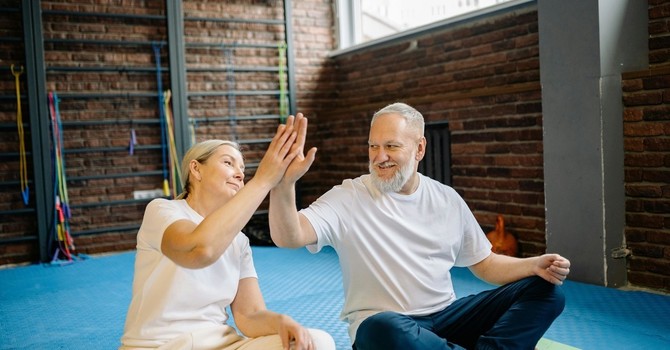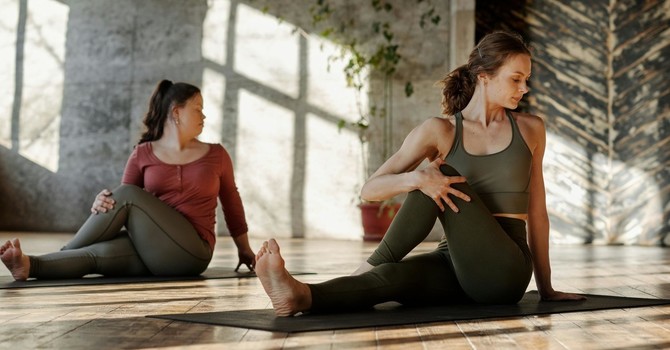
We know that sitting for prolonged periods of time is bad for our health, but many people are required to spend the bulk of their day behind a desk. If standing isn’t an option, here are some ways to re-adjust your workspace so you can work more comfortably and ward off potential injuries.
- Adjust your chair – The seat height of your chair should allow your feet to rest flat on the ground with your thighs parallel to the floor. The armrests of your chair should be the same height as your keyboard so that your arms rest in a neutral position, also parallel to the floor.
- Align your wrists in a neutral position – Your wrists should not bend up or down to reach your keyboard and mouse. Your elbows should bend at 90 degrees and your shoulders should be relaxed.
- Position your monitor at the correct distance – Monitors should be visible without leaning forward or straining. Your monitor should be close enough so that you won’t be tempted to lean forward to focus. The top line of type should be about 15 degrees above eye-level.
- Sit up straight – Knees, hips and elbows should all be bent at 90 degrees. Your shoulders should be relaxed and your feet should rest flat on the floor. If needed, use a footrest.
- Avoid cradling the phone – Consider using a headset or Bluetooth earpiece to keep your neck in a neutral position while talking on the phone.
- Use a lumbar roll – Position the roll slightly above your beltline to support the natural curve of your lower back.
- Avoid sitting on objects like a wallet – This will create an imbalance, placing uneven pressure on your hips and spine.
- Take breaks – Just a short break every 20 minutes will go a long way toward relieving stress. Periodically, stand up or go for a short walk.
- Try a stand up desk– Consider using an adjustable height workstation that allows you to work in a standing posture, i.e. Varidesk®.
The following exercises can help relieve workstation-related stress. Most can be performed right at your desk.
Bruegger Relief – Position your body at the edge of a chair, feet pointed outward. Your weight should be on your legs and your abdomen should be relaxed. Tilt your pelvis forward, lift your sternum, arch your back, tuck your chin and drop your arms. Move your hands apart from each other while simultaneously rotating your palms out, straightening your arms, and pinching your shoulder blades together as your hands backward. Take a few deep-cleansing breaths. Hold this stretch for several seconds, return to the start position and repeat 3-6 times, twice per day or as directed. Alternately, this exercise may be performed standing. View the video here.
Cervical Plus sign – Sit or stand, looking forward, with proper posture. Gently and deliberately ‘nod’ head up and down in a pain free range of motion. Next, from a neutral position, tilt your head toward your shoulder from side to side. *Do not “roll” your head in a circle. Perform 3 sets of 10 repetitions twice a day. View the video here.
Levator Stretch – While sitting, grasp the seat of your chair with your left hand. Rotate your head toward the right and look downward toward the floor. Place your right hand over the top of your head and gently pull down and diagonally in the direction you are looking. Against the resistance of your hand, contract your neck in an attempt to push your head backward/diagonally from the direction you are looking for seven seconds. Relax and gently pull your head further toward the floor to increase the stretch. Lock into this new position, and make sure that you continue to keep your head rotated in the direction that you are pulling. Perform three contract/relax cycles on each side twice per day or as directed. View the video here.
Pectoral Corner Stretch – Begin standing, facing a corner with your palms on the walls above head level. Step toward the corner and “lean in” to stretch your chest muscles. Against the resistance of the wall, attempt to push your hands into the wall and toward each other for 7 seconds. Relax and “lean in” to increase the stretch. Lock into this new position and repeat 3 contract/ relax cycles, twice per day or as directed. View the video here.
YTWL – Stand with your straight arms raised above your head in a “Y” position. Squeeze your shoulder blades together and downward throughout the following sequence of movements. Lower your straightened arms to shoulder level, into a “T” position. Next bend your elbows so that your fingers are pointing straight up while slightly lowering your elbows to make a “W”. Finally, while keeping your elbows bent 90 degrees, lower your arms to your sides so that your elbows are touching your ribs to form an “L” on each side and squeeze. Hold each position for 1-2 seconds and repeat 3 sets of 10 repetitions, twice per day or as directed. View the video here.
Standing wrist flexor stretch – Straighten your arm in front of you with your hand at chest level, palm up. Keep your elbow locked and use your opposite hand to grasp your fingers and gently pull down on your fingers until you feel a stretch in your forearm. Keep your elbow straight throughout the exercise. Against the resistance of your opposite hand, contract your wrist and fingers upward for seven seconds. Relax and increase the stretch on your wrist and forearm by pulling downward and backward on your fingers. “Lock in” to the new position and repeat three contract/relax cycles twice per day or as directed. View the video here.
Sitting for long periods of time is not ideal, but sometimes, standing isn’t an option. Be sure to take breaks, stretch, and give yourself a “desk audit” to identify the necessary changes. Most importantly, don’t ignore ongoing discomfort. If you or someone you know suffers from workstation-related pain, call our office today to see how we can help you live more comfortably.




